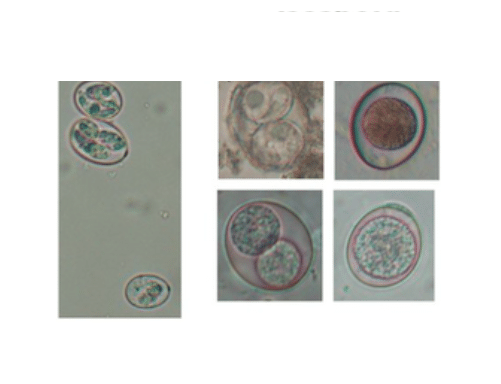ISOSPORA (Coccidian Protozoa)
These protozoa are known as the enteric coccidia; monoxenous (one-host) parasites in the digestive tracts of herbivores or carnivores causing diarrhoeal disease (known as coccidiosis). Parasites form environmentally-resistant oocysts which undergo faecal-oral transmission between hosts. There are three sequential stages in the parasite life-cycle: endogenous multiplication by asexual merogony (variously known as schizogony) followed by sexual gamogony (♂ microgametes fertilize ♀ macrogametes producing oocysts) which are excreted and undergo asexual sporogony (forming sporocysts containing infective sporozoites). Many genera are recognized on the basis of oocyst configuration (the number of sporocysts per oocyst, and the number of sporozoites per sporocyst).
Coccidian parasites form three developmental stages: schizonts, gamonts and oocysts. Schizonts first appear as small basophilic rounded cells (mother meronts) located intracellularly within host cells. The meronts form numerous daughter merozoites by endogenous division of the nucleus followed by cytokinesis.
Infections have been detected throughout the world, mainly in carnivores (particularly canids and felids) as well as in some omnivores (humans, pigs, lizards) and birds (especially passerines). Most coccidian species are considered to be highly host-specific and only parasitize single host species (oioxenous), although some species in birds and reptiles may parasitize closely-related hosts (stenoxenous) or even unrelated hosts (euryxenous)

Many hosts also harbour multiple species of coccidia which may vary considerably in morphology, developmental cycle, site of infection and pathogenicity. Three Isospora spp. have been described from dogs, 2 species from cats, one from pigs and one from humans. Other small coccidian species found in some of these hosts include Sarcocystis, Frenkelia, Hammondia, Besnoitia spp. and Toxoplasma gondii.
Infections are passed between hosts by the faecal-oral transmission of infective oocysts contaminating the external environment, including food and water supplies. Following ingestion by susceptible hosts, the oocysts and sporocysts excyst in the intestines releasing their contained sporozoites which invade host cells.


